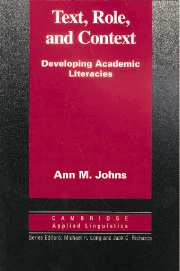Book contents
- Frontmatter
- Contents
- Series editors' preface
- Preface
- Acknowledgments
- 1 Literacy and pedagogy: Three views
- 2 Genre knowledge and socioliteracies: What readers and writers may share
- 3 Genre and social forces: “Homely” and academic texts
- 4 Discourse communities and communities of practice: Membership, conflict, and diversity
- 5 Special roles: Literacy practitioners as campus mediators and researchers
- 6 Students as researchers: Investigating texts, processes, and contexts
- 7 The socioliterate classroom: Basic tenets and goals
- 8 Putting tenets and goals into practice: Using portfolios in literacy classrooms
- 9 Conclusion
- References
- Index
5 - Special roles: Literacy practitioners as campus mediators and researchers
Published online by Cambridge University Press: 05 October 2012
- Frontmatter
- Contents
- Series editors' preface
- Preface
- Acknowledgments
- 1 Literacy and pedagogy: Three views
- 2 Genre knowledge and socioliteracies: What readers and writers may share
- 3 Genre and social forces: “Homely” and academic texts
- 4 Discourse communities and communities of practice: Membership, conflict, and diversity
- 5 Special roles: Literacy practitioners as campus mediators and researchers
- 6 Students as researchers: Investigating texts, processes, and contexts
- 7 The socioliterate classroom: Basic tenets and goals
- 8 Putting tenets and goals into practice: Using portfolios in literacy classrooms
- 9 Conclusion
- References
- Index
Summary
The role of literacy in academic life has remained largely transparent – unexamined (Russell, 1991, p. 7).
The development of socioliteracies requires interaction and analysis using a variety of texts, roles, and contexts. If we are to encourage socioliterate practices among our students, we must model for them the ways in which these interactions can take place. We must carve out for ourselves unusual, mediating roles, which ensure collaboration with faculty and administrators, promote student and faculty literacy research, and encourage projects that require all faculty to take responsibility for student literacy growth. There are obstacles to be surmounted in these mediating and research efforts; however, if we promote our goals in ways that are consistent with those of influential faculty and campus administrators, we can recruit powerful partners in our literacy efforts.
This chapter addresses the following questions relating to our roles as mediators within academic contexts:
What obstacles stand in the way of involving discipline-specific (DS) faculty in the promotion of socioliteracy?
What are some of the ways in which we can involve DS faculty in literacy research?
In what ways can literacy and DS faculty join in pedagogical endeavors?
How are the WAC/LAC programs designed to promote faculty interest in literacies?
Obstacles to campus innovation
Good teaching unrewarded
In many academic settings, DS faculty are not particularly interested in changing their approaches to teaching in order to improve student literacies or critical thinking. Why is this the case? There are a number of reasons. The first is that faculty tend to behave in their classrooms in ways that are comfortable and familiar. When they were university students, their teachers lectured, so they lecture; their own university classes required textbooks, so they require them as well. They were examined through in-class essays or multiple-choice questions, so they examine their students in the same way.
- Type
- Chapter
- Information
- Text, Role and ContextDeveloping Academic Literacies, pp. 71 - 91Publisher: Cambridge University PressPrint publication year: 1997

